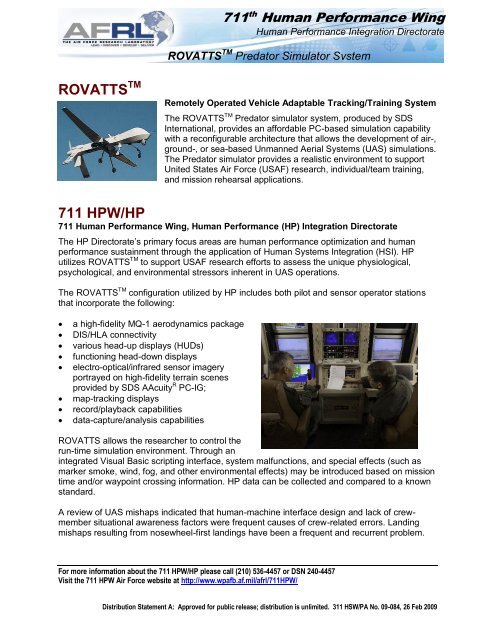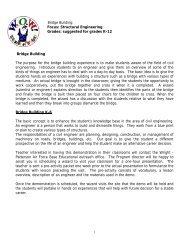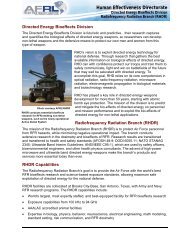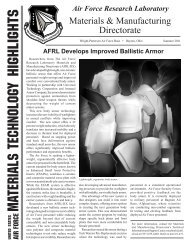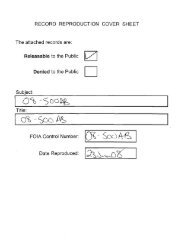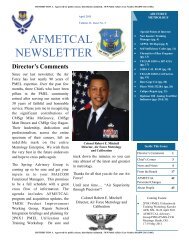ROVATTS Prototype HUD Symbology - Wright-Patterson Air Force ...
ROVATTS Prototype HUD Symbology - Wright-Patterson Air Force ...
ROVATTS Prototype HUD Symbology - Wright-Patterson Air Force ...
Create successful ePaper yourself
Turn your PDF publications into a flip-book with our unique Google optimized e-Paper software.
711 th Human Performance WingHuman Performance Integration Directorate<strong>ROVATTS</strong> TM Predator Simulator System<strong>ROVATTS</strong> TMRemotely Operated Vehicle Adaptable Tracking/Training SystemThe <strong>ROVATTS</strong> TM Predator simulator system, produced by SDSInternational, provides an affordable PC-based simulation capabilitywith a reconfigurable architecture that allows the development of air-,ground-, or sea-based Unmanned Aerial Systems (UAS) simulations.The Predator simulator provides a realistic environment to supportUnited States <strong>Air</strong> <strong>Force</strong> (USAF) research, individual/team training,and mission rehearsal applications.711 HPW/HP711 Human Performance Wing, Human Performance (HP) Integration DirectorateThe HP Directorate’s primary focus areas are human performance optimization and humanperformance sustainment through the application of Human Systems Integration (HSI). HPutilizes <strong>ROVATTS</strong> TM to support USAF research efforts to assess the unique physiological,psychological, and environmental stressors inherent in UAS operations.The <strong>ROVATTS</strong> TM configuration utilized by HP includes both pilot and sensor operator stationsthat incorporate the following:a high-fidelity MQ-1 aerodynamics packageDIS/HLA connectivityvarious head-up displays (<strong>HUD</strong>s)functioning head-down displayselectro-optical/infrared sensor imageryportrayed on high-fidelity terrain scenesprovided by SDS AAcuity R PC-IG;map-tracking displaysrecord/playback capabilitiesdata-capture/analysis capabilities<strong>ROVATTS</strong> allows the researcher to control therun-time simulation environment. Through anintegrated Visual Basic scripting interface, system malfunctions, and special effects (such asmarker smoke, wind, fog, and other environmental effects) may be introduced based on missiontime and/or waypoint crossing information. HP data can be collected and compared to a knownstandard.A review of UAS mishaps indicated that human-machine interface design and lack of crewmembersituational awareness factors were frequent causes of crew-related errors. Landingmishaps resulting from nosewheel-first landings have been a frequent and recurrent problem.For more information about the 711 HPW/HP please call (210) 536-4457 or DSN 240-4457Visit the 711 HPW <strong>Air</strong> <strong>Force</strong> website at http://www.wpafb.af.mil/afrl/711HPW/Distribution Statement A: Approved for public release; distribution is unlimited. 311 HSW/PA No. 09-084, 26 Feb 2009
711 th Human Performance WingHuman Performance Integration Directorate<strong>ROVATTS</strong> TM Predator Simulator SystemThe UAS crew consists of pilots and sensor operatorsoperating from a Ground Control Station built into asingle 30-foot trailer. Field operating units task theUAS crew to link imagery or real-time video back tothe field units. Lack of visual reference to the outsideworld makes the Predator UAS inherently difficult toland given the constraints on, and limitations of,human perception.Pilots currently use an egocentric (“local awareness”)<strong>HUD</strong> symbology; however, studies identified the needfor a new exocentric (“global awareness”) UAS <strong>HUD</strong>symbology to compensate for current UAS pilot lackof visual reference to the outside world.Egocentric (“local awareness”) UAV <strong>HUD</strong><strong>Symbology</strong>Researchers in HP successfully utilized <strong>ROVATTS</strong> TM to develop a prototype <strong>HUD</strong> symbologyset to allow landings without visual reference to the outside world. The symbology set providesan integrated display of roll, pitch, yaw, airspeed, and height above touchdown as well as otherpertinent information required for landing, to include localizer and glideslope deviation, runwaydistance, and landing-gear position in relation to the runway surface. The study demonstratedthat it is feasible to develop a <strong>HUD</strong> symbology that enables pilots to land without visualreference to the outside world and without requiring modification to the system hardware—anexample of optimizing human performance through HSI.<strong>Prototype</strong> exocentric <strong>HUD</strong> <strong>Symbology</strong><strong>Prototype</strong> exocentric (“global awareness”)<strong>HUD</strong> <strong>Symbology</strong> with graphics overlayThe HP directorate also utilizes <strong>ROVATTS</strong> TM to clarify the application of HSI to address humanperformance capability gaps to students attending the USAF School of Aerospace Medicine.Based upon the success of the currently fielded <strong>ROVATTS</strong> TM Predator simulator, SDS wasawarded a contract by the USAF to develop an MQ-9 Reaper version of its <strong>ROVATTS</strong> TMsimulator line.For more information about the 711 HPW/HP please call (210) 536-4457 or DSN 240-4457Visit the 711 HPW <strong>Air</strong> <strong>Force</strong> website at http://www.wpafb.af.mil/afrl/711HPW/Distribution Statement A: Approved for public release; distribution is unlimited. 311 HSW/PA No. 09-084, 26 Feb 2009


